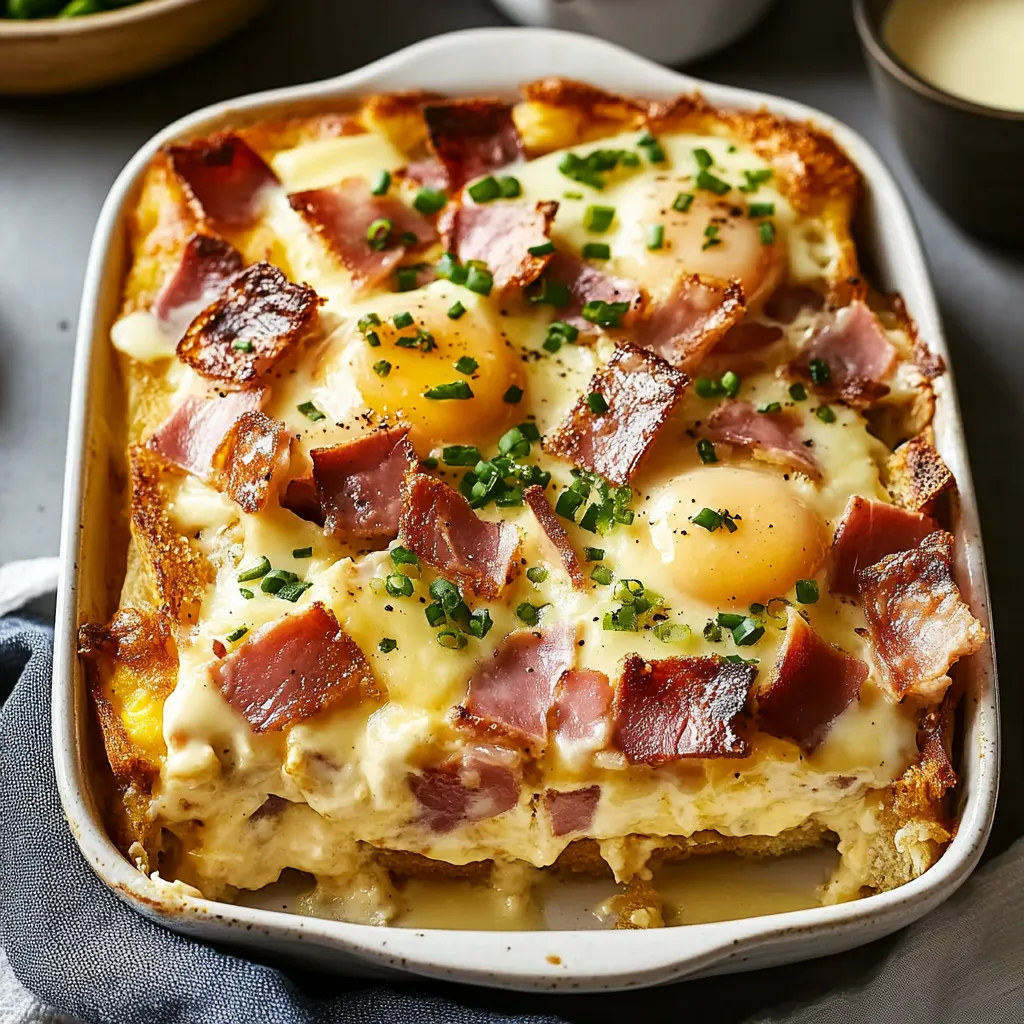 Pin it
Pin it
This eggs benedict casserole transforms the classic brunch dish into a make-ahead masterpiece that feeds a crowd with minimal morning effort. The familiar flavors of Canadian bacon, English muffins, and rich hollandaise come together in a format that lets you enjoy your morning coffee instead of poaching eggs to order.
I created this recipe after a disastrous Mother's Day when I spent the entire morning poaching individual eggs instead of enjoying time with family. Now this casserole is our holiday morning tradition, giving me the gift of presence with loved ones.
Ingredients
- Canadian bacon: Adds that classic eggs Benedict flavor without the hassle of cooking individual slices
- English muffins: Provide the perfect texture that soaks up the egg mixture while maintaining structure
- Large eggs: Form the custardy base that binds everything together
- Whole milk: Creates richness in the egg base providing better mouth feel than lower fat alternatives
- Onion and garlic powder: Add depth of flavor without the texture of fresh aromatics
- Paprika: Brings a subtle warmth and beautiful color to the finished dish
- Fresh chives: Provide a bright pop of color and mild onion flavor for garnish
- Egg yolks: Form the base of the hollandaise sauce with their natural richness
- Heavy cream: Stabilizes the hollandaise and prevents separation
- Lemon juice: Cuts through the richness with essential acidity
- Dijon mustard: Adds a subtle tang and helps emulsify the sauce
- Cayenne: Provides just a hint of heat that wakes up the palate
- Butter: Creates the luxurious silky texture that defines a proper hollandaise
Step-by-Step Instructions
- Prepare the baking dish:
- Thoroughly coat a 9x13 inch baking dish with cooking spray focusing on the corners and sides where sticking is most likely to occur. This ensures easy serving later.
- Create the layers:
- Scatter half of the diced Canadian bacon across the bottom of the baking dish creating an even layer. Tear the English muffins into bite-sized pieces and distribute them evenly over the bacon. Top with the remaining Canadian bacon ensuring good distribution throughout.
- Make the egg mixture:
- In a large bowl whisk together the eggs milk onion powder garlic powder and paprika until completely combined and slightly frothy. The thorough whisking incorporates air which helps create a lighter texture in the final casserole.
- Combine and rest:
- Pour the egg mixture slowly over the layered ingredients allowing it to seep into all the nooks and crannies between the English muffin pieces. Cover the dish tightly with plastic wrap and refrigerate for at least 5 hours preferably overnight. This resting period allows the English muffins to fully absorb the egg mixture.
- Prepare for baking:
- Remove the casserole from the refrigerator and let it stand at room temperature for 30 minutes while you preheat the oven to 375°F. This takes the chill off and promotes more even baking.
- Bake covered:
- Cover the baking dish with aluminum foil and bake for 35 minutes. The foil prevents the top from browning too quickly before the center is cooked through.
- Finish baking:
- Remove the foil and continue baking for approximately 15 minutes until the casserole is puffed slightly golden on top and set in the center. A knife inserted in the center should come out clean or with just a few moist crumbs.
 Pin it
Pin it
The English muffins are truly the secret hero of this recipe. While experimenting with different breads, I found that only English muffins maintain their delightful chewy texture after soaking overnight. My husband initially questioned using them whole rather than toasting them first, but the untreated muffins actually create the perfect texture contrast between crisp top and custardy interior.
Storage and Reheating
This casserole keeps beautifully in the refrigerator for up to 3 days. Cover leftover portions tightly with plastic wrap or transfer to airtight containers. When reheating individual servings, microwave for 60-90 seconds at 70% power to prevent the eggs from becoming rubbery. For the best texture, cover the portion with a damp paper towel while reheating.
Make It Your Own
While traditional Eggs Benedict features Canadian bacon, this recipe welcomes creative substitutions. Try using smoked salmon for a Eggs Royale version, or sautéed spinach and artichokes for a vegetarian Eggs Florentine interpretation. Ham steak diced into small cubes works wonderfully as a more economical alternative to Canadian bacon.
Hollandaise Success
Making hollandaise sauce intimidates many home cooks, but using a blender method simplifies the process dramatically. The key is adding the butter in a very slow, steady stream while the blender runs continuously. Too fast, and your sauce might break.
 Pin it
Pin it
This recipe makes every brunch easier while still delivering indulgent, classic flavors. Treat your guests—and yourself—to the perfect casserole!
Frequently Asked Questions
- → Can I make this casserole without refrigerating overnight?
While overnight refrigeration allows the flavors to develop and the English muffins to absorb the egg mixture, you can reduce the time to a minimum of 5 hours if needed. The texture is best when prepared ahead, but in a pinch, even 3-4 hours will work, though the result may be slightly less cohesive.
- → What can I substitute for Canadian bacon?
Ham is the closest substitute for Canadian bacon, but you could also use cooked regular bacon, prosciutto, or even smoked salmon for a different twist. For a vegetarian version, sautéed mushrooms or spinach can provide savory flavor.
- → How do I know when the casserole is fully cooked?
The casserole is done when the center is set and no longer jiggly. A knife inserted in the center should come out clean, and the top should be golden brown. If the top browns too quickly while the center remains undercooked, cover loosely with foil for the remainder of the baking time.
- → Can I make the hollandaise sauce ahead of time?
Hollandaise is best made fresh just before serving as it can separate when reheated. However, you can keep it warm for up to an hour in a thermos or in a bowl set over warm (not hot) water. If it thickens too much, whisk in a few drops of warm water to restore the consistency.
- → How should I store and reheat leftovers?
Store leftover casserole in an airtight container in the refrigerator for up to 3 days. Reheat individual portions in the microwave for 1-2 minutes or until heated through. For the best texture, reheat in a 325°F oven, covered with foil, for about 15-20 minutes. Store leftover hollandaise separately and make fresh sauce for reheated portions if possible.
- → Can this casserole be frozen?
You can freeze the unbaked casserole for up to 1 month. Thaw completely in the refrigerator overnight before baking as directed, adding 10-15 minutes to the baking time if it's still cold. The hollandaise sauce should not be frozen as it will separate when thawed.
